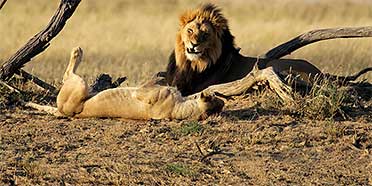A Kgalagadi Transfrontier Park visit is an experience of adaption of life to a desert environment
A review of the Kgalagadi Transfrontier Park, South Africa by Alan Crawford
The Kgalagadi Transfrontier Park is situated 260km north of Upington, South Africa and the South African section of the park is wedged between Namibia on the left and Botswana to the right. The term “Transfrontier” comes from the fact that the park spans two countries namely South Africa and Botswana and the park is jointly managed by both countries.
Our trip to the Kgalagadi Transfrontier Park was undertaken in December 2016 during summer. The weather at this time of the year is very hot with temperatures averaging between 32 degrees and 45 degrees centigrade. The heat is a dry heat without humidity and temperatures cool down in the evening into the twenties. In winter temperatures the night time temperatures can be below freezing point.
Whilst temperatures are hot at this time of the year there are advantages for game viewing as animals normally congregate close to the many water holes in the park. The geography park is a desert environment which has two dry rivers the Auob River that flows once every 10 years and the Nossob River that flows every 100 years. In summer the afternoon storms are spectacular as they are intense and occasionally are accompanied by dust storms.
The Kgalagadi is home to the black maned lions and during this year’s trip we were able to see 42 different lion at various locations in the park. Cheetahs were active as the onset of early rains resulted in the large herds of Springbok migrating off the dues into the river beds where fresh shoots of vegetation were growing. After dry periods when the first rains start you can see the change in colours overnight as the fresh shoots of grass and leaves on the “Drie Doring” (three thorn) shrubs start growing immediately. The Springbok can hold back the birth of their young until the rains come. When this takes place the cheetahs are very active hunting the young springbok lambs. Leopards, although difficult to see, are abundant in the park and often hide out in the rocky limestone outcrops where they can survey the riverbeds for prey. The Kgalagadi has high numbers of brown hyena, which are shy animals but often seen in the early morning.
A number of antelope species are found in the park with the dominant species being Springbok, Gemsbok (Oryx), Red Hartebeest, Kudu and Steenbok. During some seasons when water is scarce in the Central Kalahari in Botswana large herds of Eland, the biggest antelope in Southern Africa, migrate into the park.
The Kgalagadi is not always about the big animals but also a number of other interesting mammals such as the Honey Badger, Ground Squirrels, Mongoose, Surricates (Meercats), Cape Fox, Aardwolf, Pangolin, Black Backed Jackal, Porcupine, Caracal, and African Wild Cat that occur in the park.
Reptiles such a Tree Agamas, Cape Cobra, Puff Adders are often prey for the many small raptors, owls and eagles found in the park.
There are approximately 280 species of bird that occur in the park of which about 92 are permanent residents. During summer birdwatching is excellent as the area has a very high concentration of raptors that follow the rain fronts and feed on termite eruptions. During our trip we were able to tick off 92 different bird species.
There are three main camps Twee Rivieren, Mata Mata and Nossob. These offer a variety of accommodation from campsites, bungalows to family cottages. Only Twee Rivieren has power for 24 hours whilst Mata Mata and Nossob have generated power form 5.00am to 10.00pm. Most accommodation contains a fridge, hot plate or gas cooker top, microwave oven and the basic crockery and cutlery. Apart from the main camps there are three wilderness camps that are unfenced and offer a wilder experience being more remotely positioned but with modest “luxury’ facilities. Only Twee Rivieren has a restaurant and self-catering is required in all other camps. The three main camps have shops which carry beverages, basic food stuff, meat, curios and basic toiletries.
Apart from the South African side of the park guests can make use of two lodges on the Botswana side of the park one based at Rooiputs in the south and the other at Polenswa in the north of the park. There are also camps at Rooiputs and Polenswa that are completely unfenced and a vehicle with a roof top tent is essential as the camps are often frequented by lion.
Visitors can fly into Upington and rent vehicles to travel to the park although double cab pickup trucks will handle the gravel roads better and the higher vantage point facilitates better game viewing. Upington is a good travel hub to use as the Augrabies Falls National Park is only 112km away. Travelling into Namibia is also possible from Upington.
Further details of the park can be obtained by visiting the South African National Parks website on www.sanparks.org
For a sample of photos of the animals of the park visit https://www.flickr.com/photos/alanjcrawfordphotography/

![5-Day Kgalagadi Guided Self-Drive Mid Range Tour]()

![5-Day Kgalagadi Guided Self-Drive Budget Camping Tour]()

![8-Day Kalahari Guided Self-Drive Budget Camping Tour]()


 South Africa Parks
South Africa Parks Botswana Parks
Botswana Parks
















